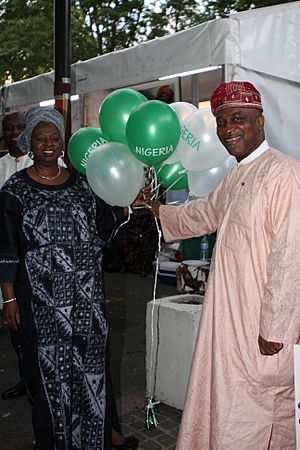National Multicultural Festival facts for kids
Quick facts for kids National Multicultural Festival |
|
|---|---|
 |
|
| Date(s) | February |
| Frequency | Annually |
| Location(s) | Canberra, Australia |
| Inaugurated | 1981 |
| Attendance | 260,000 (2013 estimated) |
The National Multicultural Festival is a big, free community party held every February in Canberra, Australia. It's a special event that celebrates all the different cultures that make up Australia. People from over 170 countries share their traditions, food, music, and dances.
The very first festival happened in 1981. It was a small, one-day event. By 1996, it officially became the National Multicultural Festival. It grew into a huge celebration. Today, it's one of Australia's most successful multicultural events. The festival now runs for three days each year. The ACT Government helps support and organize this amazing festival.
Festival History
The first festival celebrating different cultures was held in 1981. It was a one-day event in Civic, Canberra. It celebrated Australia Day. By 1988, the festival had grown a lot. It featured about 40 international food stalls. There was also lots of music and dancing. A parade led by Chinese lion dancers was part of the fun.
In 1997, the festival became a week-long event. This was a way to celebrate Canberra's many cultures. In 2010, the festival changed to a three-day event. It has stayed that length ever since.
The festival keeps growing bigger each year. In 2012, there were a record 350 stalls. The festival is very popular. In 2013, it was named "Favourite Attraction and Event" by Out In Canberra People's Choice Awards. The weather at the festival is often hot and dry. Organizers sometimes give out thousands of water bottles.
The festival helps Canberra's economy. The 2014 event brought in about $5 million. It also encouraged many visitors to stay overnight in Canberra.
Festival Changes Due to COVID-19
The COVID-19 pandemic caused some changes for the festival. The 2021 festival was first postponed. Then, it was completely cancelled. The next event was planned for February 2022. This would have been its 25th anniversary. However, the 2022 festival was also cancelled. This happened because the planning team helped with Canberra's COVID-19 response. The festival was then planned to return in February 2023.
Fringe Festival Events
From 2004 to 2009, a "Fringe Festival" was part of the Multicultural Festival. It was a free event. In 2009, the Minister for Multicultural Affairs, John Hargreaves, announced a change. The main Multicultural Festival would be shorter. The Fringe Festival would move. It became part of the National Folk Festival.
The 2013 National Multicultural Festival had a Fringe Festival again. This was the first time since 2009. The 2013 Fringe ran for just one night. Its funding came from government arts money. The Fringe Festival continued in 2014.


